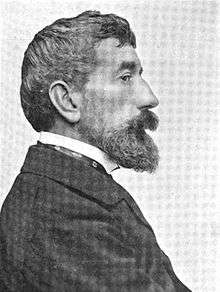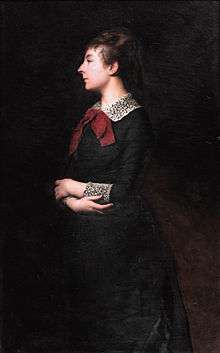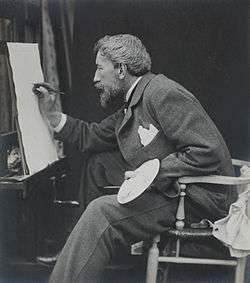Louis-Maurice Boutet de Monvel
| Louis-Maurice Boutet de Monvel | |
|---|---|
 | |
| Born |
Louis-Maurice Boutet de Monvel 18 October 1850[1] Orléans, France |
| Died |
16 March 1913 (aged 62) Paris |
| Occupation | painter and illustrator |
| Nationality | French |
| Education | Julian Academy |
| Genre | watercolors, illustrations for children's books |
| Notable works |
|
| Notable awards |
|
| Spouse | Jeanne Lebaigue |
| Children | Roger |
Louis-Maurice Boutet de Monvel (18 October 1850 – 16 March 1913) was a French painter and illustrator best known for his watercolors for children's books.[2] He was a major figure in nineteenth-century children's literature illustration.
He was an academic painter who studied at the École nationale supérieure des Beaux-Arts in Paris under Alexandre Cabanel, Gustave Boulanger, Jules Joseph Lefebvre, and Carolus Duran.[3][4][5] During the late 1870s he exhibited at the Salon de Paris and earned the medal of the third class in 1878 for his painting The Good Samaritan.[4][5]
Early life and education
Boutet de Monvel was born in Orléans.[6] Grandson on his mother's side to the tenor Adolphe Nourrit (1802–1839) and great-grandson on his father's side to the great Monvel – he was the great-great-nephew of Miss Mars – Maurice Boutet de Monvel was, in his own words, from "a family of gilt-edged artists". Furthermore, his father Benjamin Boutet de Monvel (1820–1880) was a renowned physics and chemistry professor and the author of several teaching manuals.
The second child in a family of nine children, Maurice Boutet de Monvel spent the majority of his childhood in Paris, where his father taught at Charlemagne secondary school. Permitted after his A' levels to take up studies in painting, he spent a year in close proximity to Louis-Henri de Rudder (1807–1881), before joining the École des Beaux-Arts in early 1870, where he was in the same class as Alexandre Cabanel (1823–1889). Defeat in the Battle of Sedan prompted him to interrupt his studies to join up with the Armée de la Loire, a French army of the Franco-Prussian War.

With peace returned, he took lessons at the Julian Academy, working under the leadership of Gustave Boulanger (1824–1888) and Jules Lefèbvre (1839–1911), both of whom had a decisive influence over his first works. In 1873 he made his Salon debut with his canvas Tentation (Temptation). He received a bronze medal in 1878 with Le bon samaritain (The Good Samaritan; Musée d'Orléans) and a silver medal in 1880 with La leçon avant le sabbat (The lesson before the Sabbath; Nemours Chateau-Museum). However, his works at that time, strongly influenced by José de Ribera's paintings, only played with the chiaroscuro. In order to rid his palette of his bitumen and his overly coal-like blacks, he opted to work under the leadership of Carolus-Duran (1837–1911) for a time, whose use of colours was regarded as innovative. Key to this process though was setting off on a voyage to Algeria in 1876, where one of his brothers lived. The light of Kabylie was a revelation to him. Staying in Borj Bou Arreridj, he painted Mansourah and the surrounding area. Next he headed to Constantine and returned via Tunisia. He stayed in Algeria a second time in 1878, and a third time in 1880. These three trips to Algeria were to definitively alter his style of painting. From then on he worked outdoors and his palette, the two primary shades of which became orange and above all blue, involved the latter colour being used to create shadow. In this way, the first Algerian painting which Maurice Boutet de Monvel decided to show at Le Salon in 1880, Sur les hauts plateaux (On the high plateaus) – a painting which was painted in front of the motif in 1876 – shows a small pile of orange and cobalt blue tiles in a corner of the composition, an indication of his new style.
Career

His marriage on 21 June 1876 in Paris' IVth district to the daughter of another teacher from the Charlemagne secondary school, she too a native of Orléans, Jeanne Lebaigue, and the birth of their first child, Roger, in 1879, dictated the next stage of his career. Now forced to support his family, in 1881 he agreed to illustrate Les pourquoi de Mademoiselle Suzanne (Miss Suzanne's questions) by Emile Desbeaux, and, that same year, La France en Zig zag (Zig-zagging across France), a reading book by Eudoxie Dupuis published by Charles Delagrave. The latter, thrilled by the pureness and originality of his creations, then offered him the opportunity to illustrate Saint Nicolas: Journal illustré pour garçons et filles (Saint Nicolas: An illustrated journal for boys and girls). The success achieved by the new book, and particularly the illustrations created by Maurice Boutet de Monvel for the nursery rhymes and dances found within, was such that the latter published Vieilles chansons et danses pour les petits enfants (Old songs and dances for young children) at E. Plon, Nourrit et Cie in 1883, and Chansons de France pour les petits Français (Songs of France for French children) the following year. Remaining very attached to his career as a history painter, despite his initial successes as an illustrator, Maurice Boutet de Monvel offered the Société des Artistes français (Society of French Artists) of 1885 an overtly royalist canvas, L'apothéose de la canaille ou le triomphe de Robert Macaire (The Rascal's Apotheosis or the triumph of Robert Macaire; Musée d'Orléans), which earned him a prime spot in the exhibition. However, the work, which was deemed to be overly critical of the brand new republic, displeased the Deputy Secretary of State for Fine Art, Edmond Turquet, who, despite it having been unanimously celebrated by the jury, had it taken down on the eve of the private viewing. The famous art dealer Georges Petit, who was organising an exhibition in his gallery in Rue de Sèze, then offered to exhibit the canvas, but the painter Léon Bonnat was opposed to the idea. Ultimately, it was presented in Le Figaro's premises.
Whilst Maurice Boutet de Monvel believed his career as an artist to be definitively over, Edouard Detaille (1848–1912) was thoughtful enough to lend a helping hand by presenting his candidacy to the Société des aquarellistes français ("society of French watercolourists"), which he'd just founded. One of the first watercolour portraits he sent there, that of Miss Réjane's daughter in Renaissance clothing, enjoyed such tremendous success that his reputation as a portrait painter was definitively established.
Yet he was to continue with his career as an illustrator and, in addition to publishing drawings for Saint Nicolas, which he kept contributing to until 1890, he created Quand j'étais petit (When I was young) by Lucien Briart in 1886, and La farce de Maître Pathelin (The farce of Master Pathelin), a comedy from the Middle Ages organised into modern verse by Georges Gassies des Brulies at Delagrave in 1887. That same year, two of his most notable collections were also published: Nos enfants, scènes de la ville et des champs (Our children, scenes from the country and the town) by Anatole France at Hachette et Cie (the work was to be republished from time to time under the title Filles et garcons (Girls and boys)); and, at E. Plon, Nourrit et Cie, La civilité puérile et honnête racontée par l'Oncle Eugène (Puerile, honest civility recounted by Uncle Eugène), a manual on decorum for youngsters, which Boutet de Monvel designed in its entirety. In 1888, still at E. Plon, Nourrit et Cie, the latter published his famous collection of twenty-two Fables de La Fontaine which, like his Chansons de France, is still published today. In 1890 he illustrated Ferdinand Fabre's naturalistic novel Xavière with a series of watercolours which the art publisher Bussod, Valadon et Cie, successor to the Goupil company, reproduced in a colour photoengraving.

Finally, in 1896, Plon, Nourrit et Cie published Maurice Boutet de Monvel's most famous album, Jeanne d'Arc, which he once again designed entirely on his own and whose watercolours are reproduced in zincotype, a new photoengraving process using etching in conjunction with coloured inks. His admiration for the light and shadow modelling of Fra Angelico and the battle scenes of Paolo Uccello is expressed with grandeur here. The work earned its author resounding success, rightly leading to him being considered as one of the major artists of his time and bringing him international recognition. In this way, Maurice Boutet de Monvel, who is deemed by critics as having exerted a key influence over the young school in Vienna, was invited to participate in the Exhibition of Viennese Secession of 1899, which was devoted to European graphics; nineteen of his works were displayed here, in a hall decorated by Koloman Moser. That same year also saw the showcasing of some important, prestigious retrospectives of his paintings and graphics in the United States; initially at the Art Institute of Chicago, then at the Museum of Fine Arts in Boston and finally at the Pennsylvania Academy of the Fine Arts in Philadelphia. Having travelled to Chicago in person, he received a number of portrait commissions during his visit. However, the winter was particularly harsh and he fell seriously ill, in the grip of an old bronchial ailment contracted in 1870 in the Armée de la Loire's military camps.
However, at the Exposition Universelle (World Fair) of 1900, he displayed Jeanne à la Cour de Chinon (Jeanne at the Court of Chinon), the second of two panels completed for the new basilica of Le Bois-Chenu in Donrémy. This vast decorative painting earned him a gold medal. The other four panels of this set commissioned in 1896 were sadly never to be completed, however a smaller scale variant was delivered between 1905 and 1911, to senator William A. Clark, who donated it on his death to the Corcoran Gallery of Art in Washington, where it is still part of the permanent collections. Over the course of several winters, Boutet de Monvel worked on the small-scale version of his large panels which he couldn't get over having to give up on, in the reverence and cold of his studio in Nemours. In the spring of 1911, two years prior to his death following a chest illness, which had seen him laid low in Chicago, he could finally travel to Florence, whilst working on the illustration of Une vie de Saint François d'Assise (Saint Francis of Assisi's life), which was only completed in 1921 in the end.
On his death, a sizeable retrospective of his work was organised in Paris by the Manzi et Joyant Gallery, the new successors to the Goupil company, and the gallery owners for Edgar Degas and Henri de Toulouse-Lautrec. Everyone then agreed to recognise the importance of the works he brought back from his three trips to Algeria, and especially the liberty of those created during the first trip, in 1876. Everyone then agreed to recognise the essential, pioneering nature of his illustrations for children, whose great originality and exceptional freshness mean that, even today, he is the inventor and outright master of the genre.In 1987 and 1988, the Trust for Museum Exhibitions, managed by Ann Van Devanter Townsend, organised an exhibition to showcase a considerable selection of his works on paper, which was displayed at the Telfair Academy of Arts and Sciences in Savannah, Georgia (27 January - 8 March 1987), at the Society of the Four Arts in Palm Beach (20 March – 18 April 1987), at the Delaware Art Museum in Wilmington (11 May – 21 June 1987); at the Carnegie Institute in Pittsburgh (26 October – 6 December 1987); at the Corcoran Gallery of Art in Washington (21 December – 31 January 1988); and at the Oklahoma Art Center in Oklahoma City (15 February – 22 May 1988).
Children's book illustrator



Boutet de Monvel began doing illustrations for financial reasons.[5] After contributing illustrations to several magazines he published Vielles Chansons et Rondes pour les Petits Enfants (Old Songs and Rounds for Small Children) in 1883, followed the next year by Chansons de France pour les Petits Français (Songs of France for Little French People).[5] Boutet de Monvel collaborated with Anatole France for Nos Enfants (Our Children) and a number of other children's books, many of which were translated into English in the early twentieth century.[5]
According to Anita Silvey in Children's Books and Their Creators, Boutet de Monvel's skill at capturing the moods of children made him a popular portraitist for the children of leading society families in France and elsewhere.[6][5] His work was warm and sensitive and he received so many commissions for portraits that he contemplated giving up book illustration.[5]
In 1895, however, he published an illustrated children's history of Joan of Arc which has been regarded as his masterpiece.[6][5] Working epic scenes in a muted palette that he described as "It's not color, really, it is the impression, the suggestion of color", he conveyed an emotional spirituality despite his disappointment with reproduction technology. The book gained esteem although he was neither a writer nor a historian.[5] It was republished in 1973 [7] and 1980.[5]
Children's literature critic Selma G. Lanes describes his Joan of Arc illustrations:
Boutet de Monvel's full-page illustrations have a nobility and grandeur akin to the great church frescoes of the Renaissance. Their pleasingly flat rendering combined with a sophisticated use of design elements…owe a debt to the Japanese prints so popular in the artist's day.[6]
Boutet's Joan of Arc work soon became known to the English speaking world through translation.[6] In 1899 he traveled to the United States to exhibit and received a commission from a wealthy American to create a series of large scale panels based upon his Joan of Arc illustrations.[5] Another six panels originally planned for the Joan of Arc chapel near her birthplace Domrémy-la-Pucelle, France became part of the collection at the Corcoran Gallery of Art in Washington, D.C.[5]
The Buffalo, New York Fine Arts Academy, which held a collection of his works during World War I, assessed his style by stating "There is no unnecessary detail in his portraits, his studies, or any of his compositions."[3] In describing the illustrations among its exhibit a museum publication stated his "masterly creations stand out not merely as a graphic comment on the text but as a revelation of a subject which the writer has treated only in a fragmentary and superficial manner."[3]
Silvey ranks Boutet de Monvel alongside Kate Greenaway and Randolph Caldecott as leading figures of the nineteenth century golden era of children's book illustration.[5] He died in Nemours in 1913.[3]
Miscellaneous
Whittaker Chambers mentions that he read a book of etiquette illustrated by Monvel as a child.[8]
in A Moveable Feast, Ernest Hemingway mentions Boutet de Monvel's Joan of Arc Illustrations, likening Alice B. Toklas' hair to that of Joan of Arc's hair.
References
- ↑ "MAURICE BOUTET DE MONVEL EST NÉ EN 1850!" [Louis-Maurice Boutet de Monvel was born in 1850 (includes link to birth certificate)] (in French). Retrieved 18 March 2015.
- ↑ "Louis Maurice Boutet de Monvel". High Beam Encyclopedia, from the Columbia Encyclopedia, Sixth Edition. 2008. Retrieved 2008-10-25.
- 1 2 3 4 Academy Notes. Buffalo Fine Arts Academy, Albright Art Gallery (Buffalo, N.Y.). 1920. pp. 55–57. Retrieved 2008-10-25.
- 1 2 Clara Erskine Clement Waters, Laurence Hutton (1879). Artists of the Nineteenth Century and Their Works: A Handbook Containing Two Thousand and Fifty Biographical Sketches. Houghton, Osgood. p. 121. Retrieved 2008-10-25.
- 1 2 3 4 5 6 7 8 9 10 11 12 13 Anita Silvey (1995). Children's Books and Their Creators. Houghton Mifflin. p. 75–76. ISBN 978-0-395-65380-7. Retrieved 2008-10-25.
- 1 2 3 4 5 Selma G. Lanes (2006). Through the Looking Glass: Further Adventures and Misadventures in the Realm of Children's Literature. David R. Godine Publisher. pp. 223–224. ISBN 978-1-56792-318-6. Retrieved 2008-10-25.
- ↑ Gautier-Languereau, Monnier, Paris
- ↑ Chambers, Whittaker (1952). Witness. Random House. p. 109.
Further reading
- Dowdes, William Howe (1900). "Boutet de Monvel." In: Twelve Great Artists. Boston: Little, Brown & Company, pp. 93–101.
External links
| Wikimedia Commons has media related to Louis-Maurice Boutet de Monvel. |
- Works by Louis-Maurice Boutet de Monvel at Project Gutenberg
- Works by or about Louis-Maurice Boutet de Monvel at Internet Archive
- Pierre Bonnard, the Graphic Art, an exhibition catalog from The Metropolitan Museum of Art (fully available online as PDF), which contains material on Louis-Maurice Boutet de Monvel (see index)